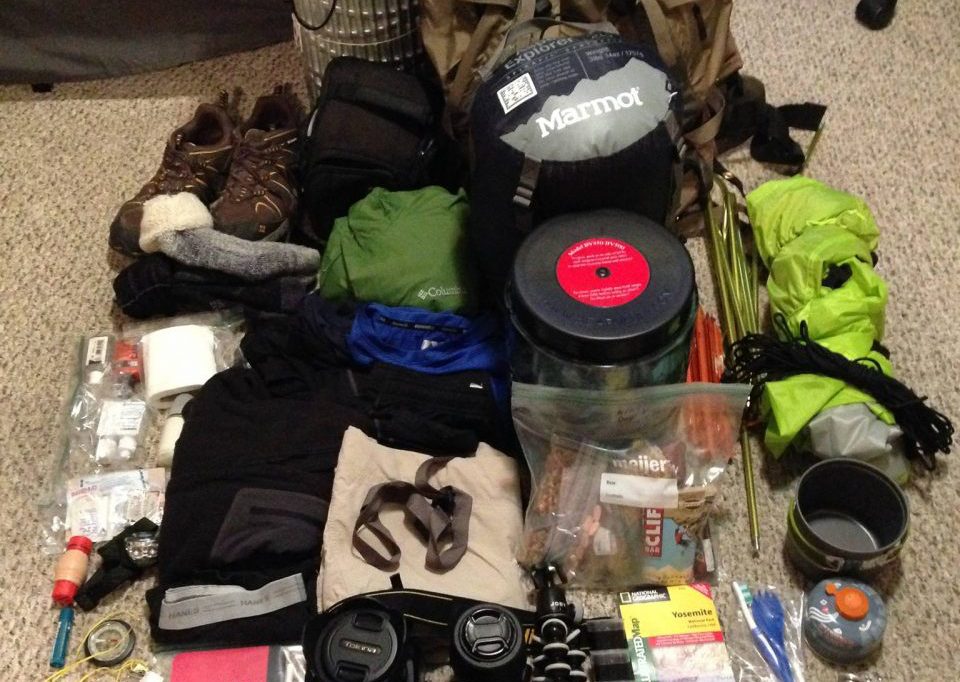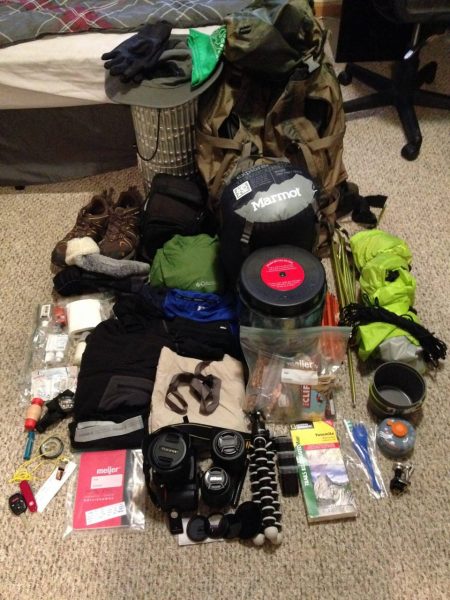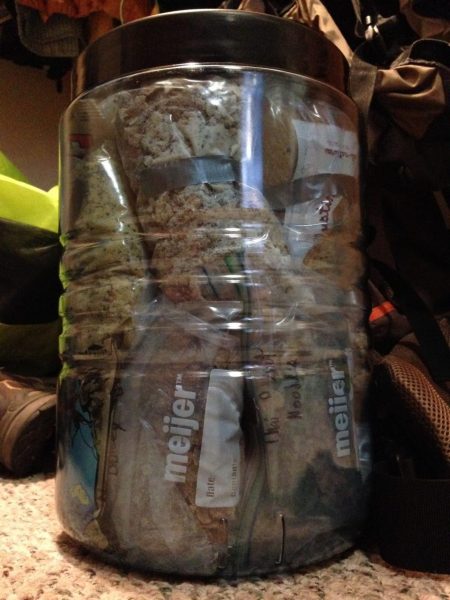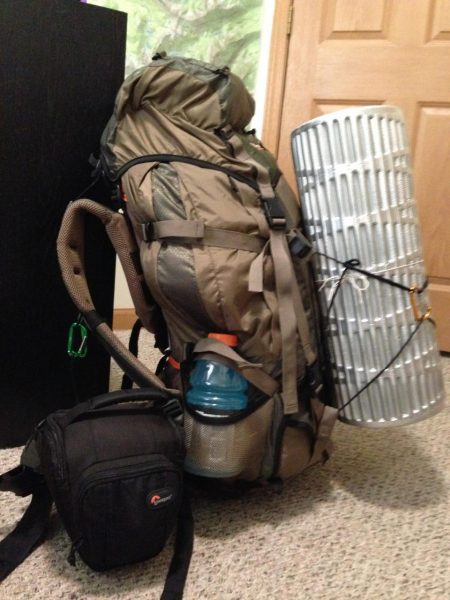At some point this spring, I discovered the existence of the John Muir Trail and quickly decided I wanted to hike it. For those not familiar with the John Muir Trail, or JMT, it coincides with a 200+ mile portion of the Pacific Crest Trail (PCT). Most folks begin at Happy Isles trailhead in Yosemite National Park and then hike southwards to Mt. Whitney. You can do the hike in the opposite direction, but it’s easier and more convenient to do the trek southbound. The only catch is that you must have a wilderness permit, and, well, those are very difficult to get because the trail is quite popular. I did try to reserve one, but I wasn’t surprised when I was informed that there were none available for the dates I wanted them.
Not to be deterred from hiking the Sierra Nevada Mountains, I have planned an alternate hike. Instead of the JMT, I will hike a 75-mile loop in Yosemite National Park. Obtaining a permit for this adventure was much easier since I will begin my trek on a less popular route. I even secured a permit for Half Dome! This will be a solo backpacking trip (my first), and I’m a little nervous about it, but my gut tells me I’ll be fine. Yosemite is a crowded park and I suspect I’ll see people every day even in the backcountry, so I shouldn’t ever be too far from help.
Acquiring Gear
Now that I have a permit and am guaranteed the ability to wander the wilderness for a week, I have to gather my supplies. I already have a Marmot “Aspen” sleeping bag, which is rated to 20 degrees F. That is much colder than I need, and the bag is a little heavy at almost 4 pounds, but I refuse to buy another bag (at least, for now… I’m a poor college student). I also have a 65L Field & Stream backpack, which should be plenty large enough to hold my supplies for a week. The pack has a built-in rain cover too!
To complete the “big three,” I bought a Eureka! Spitfire one man tent, which is quite light (~2 pounds). I also acquired a Thermarest RidgeRest sleeping pad, which weighs 14 oz and is longer than I am tall; I could trim some off to save weight if I wanted.
Clothing
I have a fair collection of synthetic clothing items from running events, so I didn’t have to buy too many items here. My day-to-day outfit will consist of a polyester short-sleeved shirt, short under-armor underwear, and a pair of synthetic cargo pants. All three items are super lightweight and breathe well. And, like most synthetic clothing, they wick moisture away from the skin. I have two pairs of wool socks so I can wear one and have a clean pair for backup in case one pair gets wet.
For colder temperatures, I have a pair of long, synthetic running pants (i.e. leggings), a fleece quarter zip jacket, and a long-sleeved synthetic shirt. I bought a light rain jacket that doubles as a wind breaker. I also picked up a hat to keep the sun off my face and neck, and a bandana; the bandana can be a bandage, water strainer, sweat band, or a hat. The best gear is multi-use gear!
My shoes are lightweight hiking boots. They don’t go over the ankle, are not made of leather, and are really more like shoes than boots. I run long distance races on a regular basis, so my legs and ankles are in good shape and I’m not worried about the lack of support.
Finally, I’m bringing a pair of gloves for my Half Dome climb. They could also be useful if it gets particularly cold, but I don’t expect temperatures lower than 50 F.
Food and Cooking
My cooking kit is small and simple. I have a can of butane, a tiny stove that screws onto the gas can, and a little pot that will hold about three cups of water. All my hot meals are of the “just-add-water” variety, so I won’t be doing any gourmet cooking. I found some hard-plastic sporks at the grocery store and am bringing one to eat with.
Rather than purchasing expensive freeze-dried meals (e.g., Mountain House), I found some recipes online. For breakfast, I made my own instant oatmeal packets using Monica’s Recipes, but doubled each recipe – I like a big breakfast. 🙂 I also made some cold cereal packets by putting a few cups of raisin bran (my favorite!) and a bit of powdered milk into a ziplock bag. Powdered milk is disgusting by itself, but it’s great with cereal!
My lunches require no cooking. I have two different meals: crackers, peanut butter, and dried apples, and crackers, cheese, and vegan jerky. I got some of those seed-filled, nutritious crackers that will fill me up quickly. Cheese sticks work well because they keep the cheese packaged separately, and Justin’s peanut butter packets have similar benefits.
For dinner, I once again referred to Monica’s Recipes and made two each of the Veggie Couscous, Creamy Alfredo Noodles, and Thai Peanut Noodles. To fit my dietary preferences, I replaced the chicken with tuna but otherwise followed her recipes to the letter. I was a bit skeptical that pouring boiling water into a freezer bag would work; I expected the plastic bag to melt. However, upon trying it at home, I was pleased to discover that the bag holds up!
For snacks, I brought a variety of Cliff Bars (2 per day), one Snickers bar for each day, and enough Gatorade powder for a 32 oz bottle every day.
Yosemite National Park requires that all food and scented items be stored in a bear canister. I don’t need to be able to fit my first day’s worth of food in the canister because I’ll eat it by the time I get to camp, but everything else must fit. I bought an 11.5 liter Bear Vault canister, which is advertised to be able to store 7 days of food. Perhaps I eat more than the average hiker, but I had a difficult time fitting 6-days’ worth of food in there.
Finally, I bought some Aquamira droplets for my water purification needs. The streams and lakes in the Sierra Nevada are typically full of cold, clear water, so it’s not likely that I’ll need to filter out dirt and other particulates. If it turns out I do need to, I’ll make use of the bandana. The droplets kill all the dangerous bacteria and germs in the water and will make it safe to drink.
First Aid and Misc
For first aid, I have a variety of items: moleskin, gauze, medical adhesive tape, large band-aids, and alcohol wipes. I have some ibuprofen tablets as well as antihistamine tablets (I’ve had mild allergic reactions to some of the pollen out west in the past). For day-to-day care, I have lip balm, sun screen, and bug spray. For toilet needs, I’ve got toilet paper and hand sanitizer; I’ll use a tent stake to dig my cat holes. Safety pins, needle and thread, and duck tape serve as repair supplies for tears or other fabric equipment malfunctions. I’ve also packed a tooth-brush but will go without tooth-paste to avoid the scent; most of the good of brushing teeth comes from the brushing action, not the toothpaste.
In the miscellaneous category, I have a pocket knife (with included tweezers and tooth-pick), a head lamp, 15-20 feet of paracord, a whistle, paper and pencil for journal writing, some matches, a key for my car, and my wilderness permit.
Photography
Most folks will stop adding weight to their pack at this point. Some might bring a small point-and-shoot camera for photos on the trail, but that’s about it. Unfortunately for my muscles, I can’t bring myself to settle for a smaller camera. One of the primary reasons I bought an expensive DSLR was so I could capture the beautiful scenery in the mountains. I’ve taken my DSLR backpacking before, and this trip will be no exception. I have a Nikon D7100 and am bringing two lenses: a Tokina 11-16mm f/2.8 and the kit Nikon 18-55mm. I have circular polarizing filters for both lenses as well as some cheap 3-stop neutral density filters. A microfiber cloth and several spare batteries complete the kit. I have a Lowepro camera holster bag that is large enough to hold my camera with a lens on the front. I’ve attached the holster bag to the hip strap on the left side of my back so I can access the camera easily while I’m hiking. Finally, I bought a Joby Gorillapod for shots that I need a tripod for. The Joby tripod is only half a pound, but it is a lot less versatile than a regular tripod. I’ll just have to get creative!
That covers all my gear! It’ll be interesting to see how everything holds up. I may discover that I need things I forgot to pack, or that I’ve packed things I don’t need. Hopefully, I don’t need any of the first aid items.
Happy trails, everyone!



